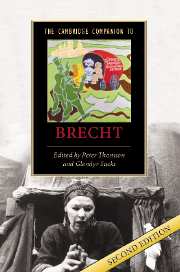Book contents
- Frontmatter
- Part I Context and Life
- Part II The Plays
- 4 Brecht’s early plays
- 5 The Threepenny Opera
- 6 Brecht’s clowns: Man is Man and after
- 7 Learning for a new society: the Lehrstück
- 8 The Good Person of Szechwan
- 9 Mother Courage and Her Children
- 10 Life of Galileo: between contemplation and the command to participate
- 11 The Caucasian Chalk Circle: the view from Europe
- Part III Theories and Practices
- Bibliography
- Index
- Series List
6 - Brecht’s clowns: Man is Man and after
from Part II - The Plays
Published online by Cambridge University Press: 28 March 2007
- Frontmatter
- Part I Context and Life
- Part II The Plays
- 4 Brecht’s early plays
- 5 The Threepenny Opera
- 6 Brecht’s clowns: Man is Man and after
- 7 Learning for a new society: the Lehrstück
- 8 The Good Person of Szechwan
- 9 Mother Courage and Her Children
- 10 Life of Galileo: between contemplation and the command to participate
- 11 The Caucasian Chalk Circle: the view from Europe
- Part III Theories and Practices
- Bibliography
- Index
- Series List
Summary
Brecht was not a great comedian, but several of his friends were. Both Karl Valentin and Charlie Chaplin influenced the playwright, and led him to invent stage characters who could be described as political clowns. The first of these clowns, Galy Gay, appeared in 1926, as the humble Irish porter who becomes a 'human fighting machine' in Man is Man.
The play remains an important document of Brecht's political humour, as well as of his development of epic theatre and a Marxist aesthetic in the 1920s. It has also been regarded as a critique of militarism, imperialism and what Brecht later called 'the bad collective' which destroys individualism; but the comic aspects of the play deserve special attention, since they reveal Brecht's innovations in political clowning. As if to acknowledge his closeness to comedy, Brecht has characters in the play speak of scenes in Begbick's canteen as 'numbers' - that is, variety acts like those performed in music halls.
The play's innovations moved the clowning of Brecht's contemporaries from cabarets and films into German theatres which were far more solemn, and less appealing to working-class audiences, than the popular art forms in which Valentin and Chaplin performed. Early in his career Brecht called for more ‘fun’ in the theatre, and the fun of clowning by Chaplin and Valentin became a model for Galy Gay’s adventures in Man is Man. ‘It’s a jolly business’ to see a man ‘surrender his precious ego’, Brecht once said about Galy Gay’s agreement to give up his name and identity, and accept that of Jeriah Jip (BT, p. 19).
- Type
- Chapter
- Information
- The Cambridge Companion to Brecht , pp. 90 - 100Publisher: Cambridge University PressPrint publication year: 2006

